What makes merienda, the Filipino tradition of midday snacks, so special? It’s a big part of the country’s food culture. It shows the nation’s history and cultural diversity. With a wide range of food options, including snacks and tradition, it brings people together.
The Philippines has over 7,000 islands. This makes its snack food tradition very diverse. You can find everything from sweet treats like ube and pandan desserts to savory snacks like peanuts and pandesal. All these snacks are part of the rich tradition of merienda, a time to enjoy food and snack with family and friends.
The merienda tradition is more than just food. It’s about the cultural significance it holds. It’s a time to bond with loved ones and take a break from daily life. This makes it an essential part of Filipino culture and tradition, with a focus on food and snack.
Key Takeaways
- Merienda is a Filipino tradition of midday snacks that brings families and friends together.
- The tradition of merienda reflects the country’s history and cultural diversity, with a wide range of food and snack options.
- Merienda is a significant part of Filipino culture, with a focus on food, snack, and tradition.
- The merienda tradition is not just about the food, but also about the cultural significance it holds, as a time to bond with loved ones.
- With over 7,000 islands in the Philippines, the country’s snack food tradition is as diverse as its landscape.
- Merienda is an essential part of Filipino culture and tradition, with a focus on food, snack, and cultural significance.
- The tradition of merienda is a time to enjoy food and snack with family and friends, and to take a break from the hustle and bustle of daily life.
Historical Origins of Merienda
Merienda is a beloved tradition in Filipino culture. It has a long history, starting from the Spanish colonial period. The Spanish brought their snacking habits, which became the merienda we love today.
Merienda has changed over time, influenced by Spanish, Chinese, and American cultures. This mix of culture and tradition makes merienda unique and varied.
Spanish Influence on Filipino Cuisine
The Spanish conquistadors introduced their cooking ways to the Philippines. This mix of tradition and cuisine created the merienda we enjoy now.
The Evolution of Merienda Through Time
Merienda has grown, using new ingredients and cooking methods. This shows the country’s rich history and culture. Today, merienda celebrates Filipino tradition and culture, uniting people through snacks.
Common Merienda Foods
Merienda is a Filipino tradition of midday snacks. It offers a wide range of food options. Whether you like sweet treats or savory snack options, there’s something for everyone.
Kakanin, puto, and halo-halo are popular merienda food items. They are often enjoyed with a cup of coffee or tea. For a savory option, try chicharon or fish balls for a crunchy snack.
Here are some common merienda food items:
- Kakanin: a variety of sweet cakes made from glutinous rice, tapioca, or cassava
- Puto: a type of steamed cake made from rice flour
- Halo-halo: a cold dessert made from shaved ice, sweetened beans, and milk
- Binatog: steamed white corn kernels mixed with shredded coconut
- Maja Blanca: a sweet pudding made from carabao’s milk or coconut milk
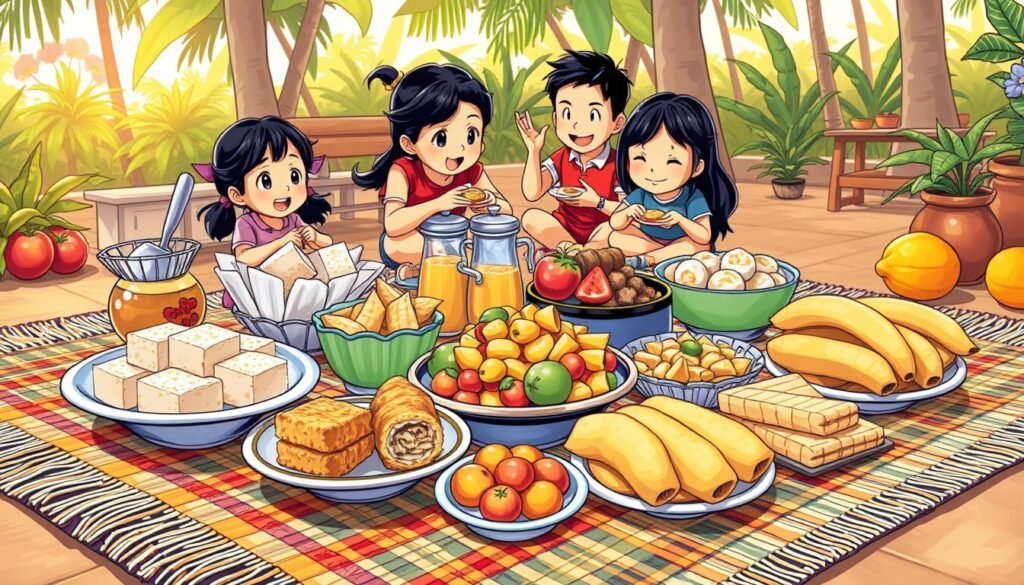
These merienda food items are not only delicious but also show the country’s cultural diversity. Whether you’re craving something sweet or savory, there’s a merienda snack for you.
| Merienda Food | Description |
|---|---|
| Kakanin | Sweet cakes made from glutinous rice, tapioca, or cassava |
| Puto | Steamed cake made from rice flour |
| Halo-halo | Cold dessert made from shaved ice, sweetened beans, and milk |
Cultural Significance of Merienda
Merienda is a big part of Filipino tradition and culture. It’s a time for families and friends to bond, share stories, and make memories. It’s also key in Filipino celebrations like birthdays and weddings, showing respect and kindness to guests.
In the Philippines, merienda is more than just a snack. It’s a way to build strong relationships and make memories that last. This tradition brings people together, creating a sense of community. Each region in the Philippines has its own special merienda dishes.
Popular merienda foods include dinuguan at puto, pansit, lumpia, ginataan, and suman. These are enjoyed in the mid-afternoon, giving a break and energy for the rest of the day. Merienda is a big part of Filipino culture and tradition, bringing people together and creating lasting memories.
Timing and Frequency of Merienda
Merienda, a traditional Filipino snack, is usually enjoyed in the afternoon, between 2-5 pm. It’s flexible, fitting into various schedules and lifestyles. This makes it a perfect way to take a break and recharge. The culture of merienda is deeply rooted in Filipino heritage. Its timing and frequency can vary by region and personal preference.
In general, merienda is a social activity that brings people together. It fosters a sense of community and culture. Whether it’s a quick snack or a leisurely break, merienda is essential in Filipino daily life. Traditionally, it’s enjoyed between 2-5 pm, when the sun is high.
Traditional Merienda Hours
Here are some key points to note about traditional merienda hours:
- Typically taken between 2-5 pm
- Flexible tradition that can be adapted to different schedules and lifestyles
- Deeply rooted in Filipino culture and heritage
Merienda Variations by Region
Merienda variations differ across the Philippines, showing the country’s diverse culture and traditions. Some regions have unique merienda customs, while others share similar practices.
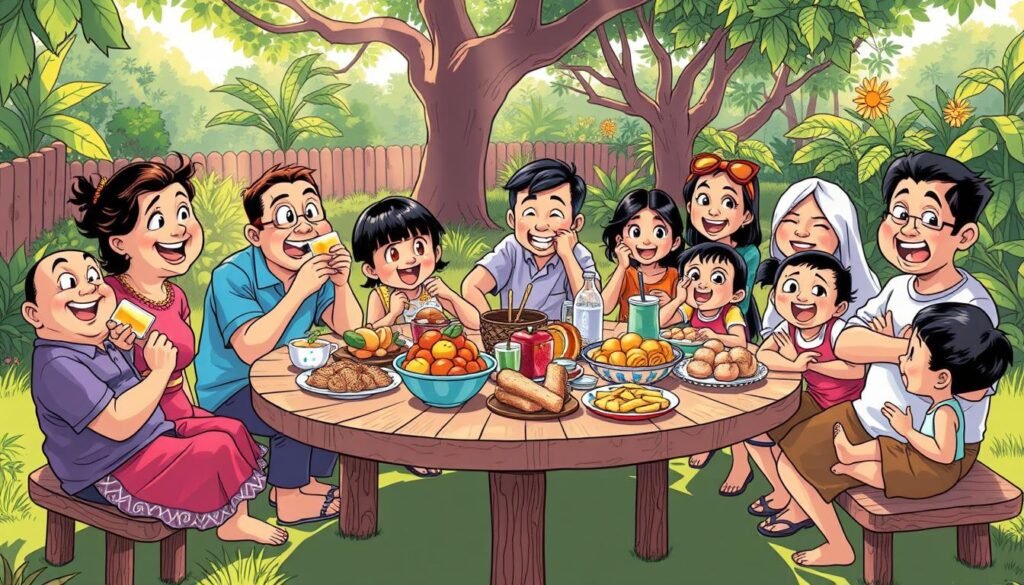
In the afternoon, Filipinos often come together to share stories, bond, and enjoy snacks. This tradition is key to Filipino culture, promoting social interaction and community.
| Region | Merienda Customs |
|---|---|
| Luzon | Traditional merienda snacks, such as rice cakes and fresh fruits |
| Visayas | Merienda variations, including sweet and savory options |
| Mindanao | Unique merienda customs, reflecting the region’s diverse culture |
How Merienda Differs Across the Philippines
Merienda, a midday snack, is a big part of Filipino food culture. Different snacks and traditions show the country’s complex history and culture. In Northern Luzon, snacks like kakanin are favorites. They’re made with sticky rice, coconut milk, and sugars.
In the Visayas, snacks are unique, like fresh mangoes and bananas. Mindanao has its own food culture, with snacks like suman and biko. These differences highlight the variety in Filipino snack culture.
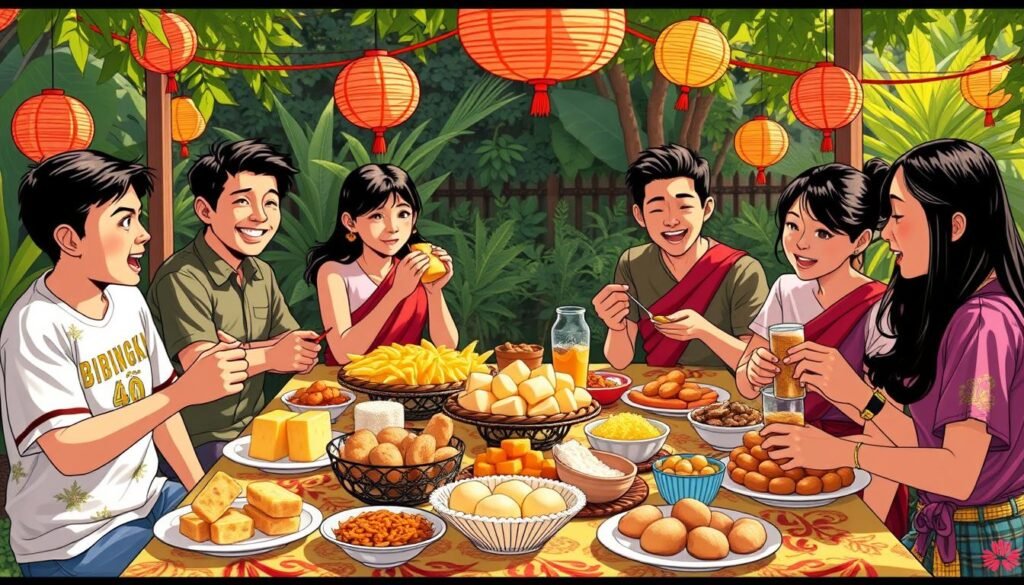
- Kutsinta, made with flour and brown sugar
- Sapin-sapin, known for its multicolored presentation
- Pancit Malabon, a noodle dish often topped with seafood
These snacks are tasty and show the country’s rich food culture and history.
| Region | Popular Merienda Snacks |
|---|---|
| Northern Luzon | Kakanin, suman, biko |
| Visayas | Fresh mangoes, bananas, sapin-sapin |
| Mindanao | Suman, biko, kutsinta |
Merienda is key to Filipino culture, showing the country’s rich history and heritage. Whether it’s a traditional snack or a new twist, merienda is a tasty journey. It highlights the country’s culinary creativity and food culture.
Merienda vs. Other Meal Times
Merienda is a special meal time in the Philippines, different from breakfast and lunch. It’s a time to refuel and get ready for the rest of the day. This tradition is key to daily life, giving people a chance to rest and recharge.
Compared to other meals, merienda is more casual and flexible. While breakfast and lunch are formal, merienda is for snack foods like cakes and cookies. It happens from 1 PM to 5:30 PM, perfect for a quick snack with friends and family.
The cultural value of merienda is clear in its popularity. Many Filipinos see it as a must-have part of their day. Skipping merienda is almost seen as a sin, showing how important it is in Filipino culture. Whether it’s a sweet or savory snack, merienda is a time to enjoy food and company, making it essential in the Philippines.
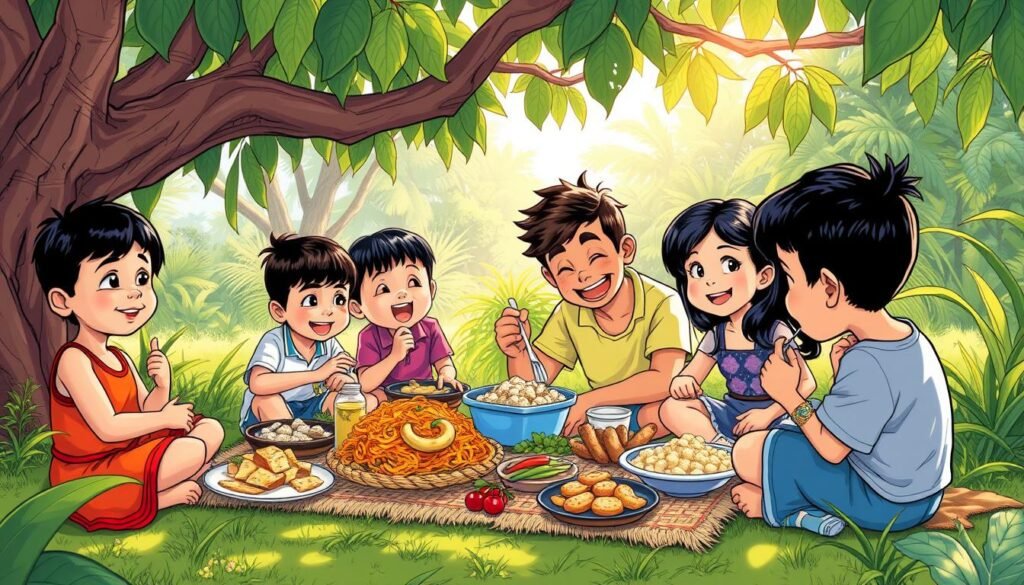
- Merienda is a unique meal time in the Philippines, distinct from breakfast and lunch.
- The merienda time frame in the Philippines typically spans from 1 PM to 5:30 PM.
- Merienda is a more casual and flexible food tradition, allowing for a variety of snack foods.
Modern Adaptations of Merienda
Merienda, a traditional Filipino snack, has changed over time. It now includes new flavors and twists. You can find everything from classic snacks like pan de sal to modern fusion dishes.
The snack industry in the Philippines is booming. This is thanks to more people wanting easy and affordable snacks. Brands like Clover Chips and Piattos lead the market with a variety of flavors.
The love for merienda is a big part of Filipino culture. Many families stick to traditional snacks, even with modern options available. This mix of old and new has led to creative and unique food choices.
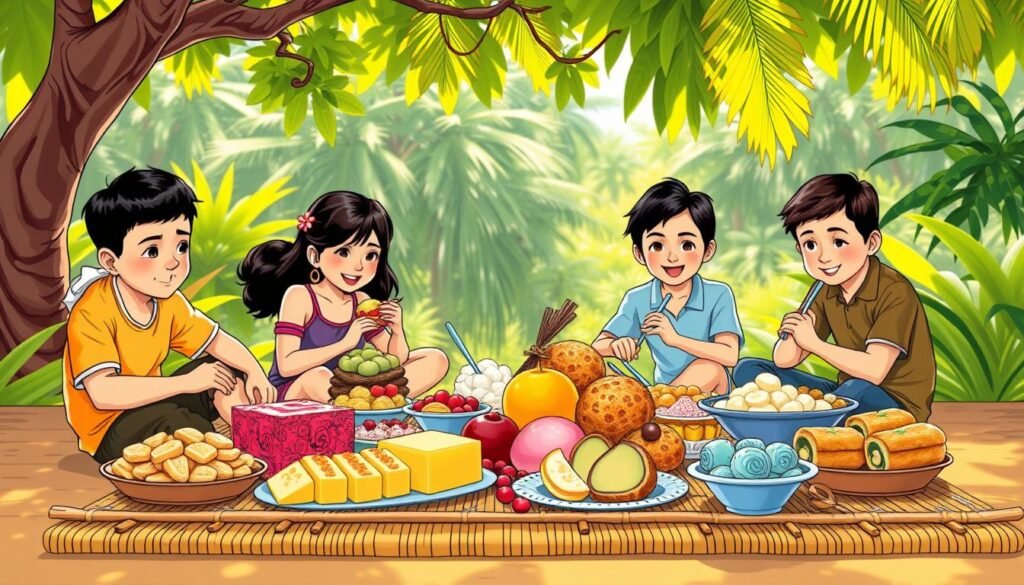
Modern merienda includes fusion foods like Korean-Filipino or Japanese-Filipino dishes. These combine Filipino ingredients with global tastes. There’s also a rise in healthier snacks, like fruit-based treats or baked goods.
These changes show how Filipino tastes are evolving. Yet, they keep the traditional culture and values of merienda alive.
How to Prepare Classic Merienda Dishes
Merienda is a traditional Filipino snack that’s a big part of the country’s food culture. Making classic merienda dishes lets you experience this tradition up close. Two favorites are cinnamon sugar tortilla and traditional bibingka.
These dishes are tasty and simple to make. They show off the Filipino food culture’s rich flavors and variety of snack options. Making merienda dishes is a great way to connect with Filipino heritage.
Cinnamon Sugar Tortilla Recipe
To make cinnamon sugar tortilla, you need tortillas, cinnamon, and sugar. Sprinkle cinnamon and sugar on the tortilla and fry until crispy.
Traditional Bibingka Recipe
Traditional bibingka is a classic Filipino food enjoyed during merienda. It’s made by mixing rice flour, coconut milk, and sugar, then baking in a clay pot. It’s a delicious and fragrant tradition loved by all.
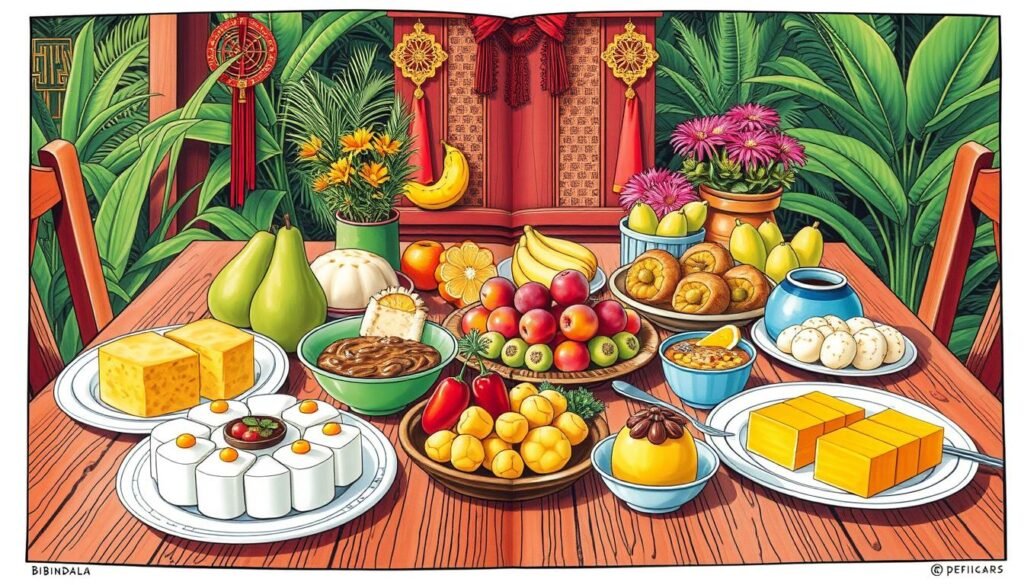
| Ingredients | Quantity |
|---|---|
| Rice flour | 2 cups |
| Coconut milk | 1 cup |
| Sugar | 1/2 cup |
By following these simple recipes, you can enjoy delicious Filipino merienda dishes at home. Whether you like sweet or savory food, there’s a merienda snack for everyone. It’s all part of the rich Filipino tradition.
Merienda and Street Food Culture
Merienda is a big part of street food in the Philippines. It offers many snack options that show the country’s rich food culture. The street food scene is lively, with many vendors and outdoor spots. These places show the nation’s love for tasty food and trying new flavors.
Visiting a street food market or outdoor eatery is a must. The smell of fried foods like fish balls and squid balls is everywhere. You can find quick and cheap food options like adobong mani and kamote fries to satisfy any hunger.
For those wanting to try something new, exploring snacks can be exciting. Whether it’s a traditional merienda dish or a modern take on a classic snack, there’s something for everyone. The world of Filipino street food and culture is vibrant and full of surprises.
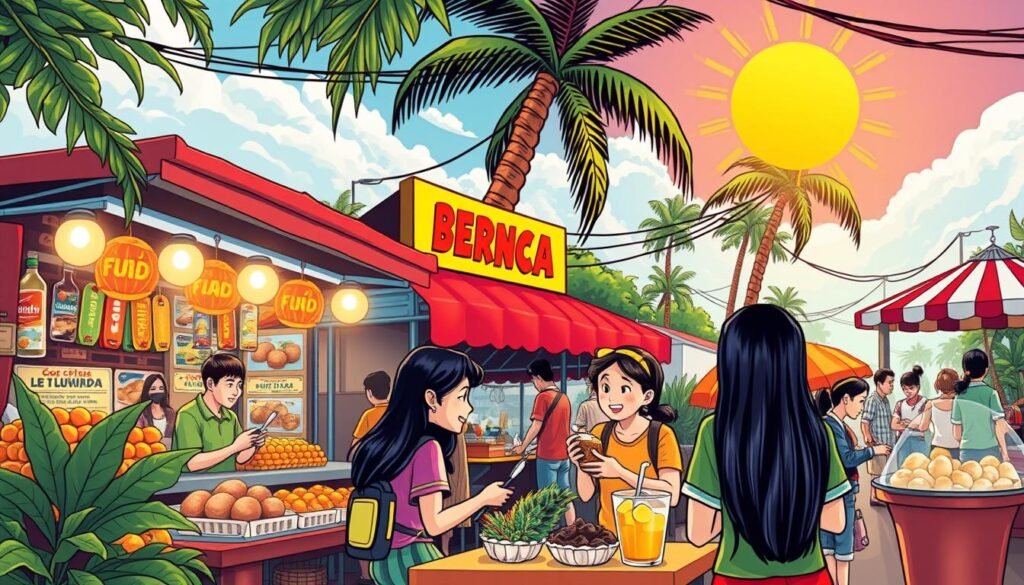
- Balut, a fertilized duck egg that’s boiled and eaten from the shell
- Penoy, a variant of balut that’s produced from eggs that don’t fully develop
- Banana q, a skewered deep-fried saba banana that’s caramelized and seasoned
Thesesnacks are tasty and give a peek into the Philippines’ richculture. In the Philippines, food is key in bringing people together.
| Merienda Option | Description |
|---|---|
| Adobong Mani | A popular snack made from peanuts cooked in vinegar and soy sauce |
| Kamote Fries | A crispy and delicious snack made from sweet potato fries |
| Banana Q | A sweet and caramelized snack made from skewered saba bananas |
Merienda in Filipino Workplaces
Merienda is key in Filipino workplaces, creating a sense of community and culture among colleagues. It’s a time for casual breaks and snack culture. This tradition shows respect and kindness through sharing food and drinks.
In many Filipino offices, merienda is a daily must. It’s a time for colleagues to share stories and enjoy each other’s company. This practice builds teamwork and camaraderie, making the workplace more enjoyable. For the best merienda snacks, check out merienda spots in the metro.
Casual Breaks and Snack Culture
Merienda is more than a break; it’s a chance to recharge and refocus. In the Philippines, merienda connects colleagues and friends over shared experiences. Whether it’s a simple snack or a full meal, it’s a time to appreciate each other’s company.
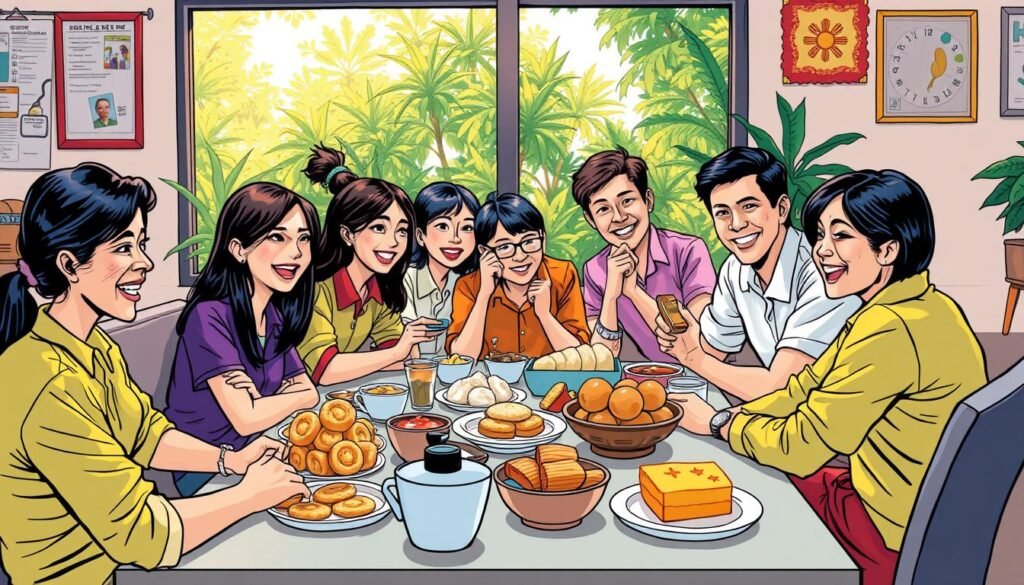
Merienda as a Team-Building Activity
Merienda is also great for team-building and collaboration. Sharing a meal or snack helps build relationships and trust. This leads to better communication, increased productivity, and a positive work environment. In Filipino workplaces, merienda is more than a tradition; it’s a way to build community and culture.
The Role of Merienda in Filipino Hospitality
Merienda is key in Filipino hospitality, showing respect and kindness to guests. It’s a tradition in the Filipino culture that reflects the country’s heritage and warm welcome. This act of generosity and welcoming is deeply rooted in Filipino tradition.
In Filipino homes, merienda is a sign of warmth and friendship. The snacks served show the country’s diverse culture and food traditions. From sweet treats like bibingka and turon to savory snacks like pulvoron and boiled saba, merienda is a time to enjoy food and conversation with loved ones.
Some popular merienda items include:
- Bibingka: a traditional Filipino rice cake
- Turon: a sweet snack made with saba and jackfruit
- Pulvoron: a powdery snack made with flour and sugar

Merienda is more than just a snack in Filipino hospitality. It’s a way to connect, build relationships, and make memories. By understanding merienda’s role in Filipino tradition and culture, we can appreciate the country’s rich heritage and warm welcome.
Tips for Hosting a Merienda Gathering
Hosting a merienda gathering is a great way to experience the tradition firsthand. From menu planning to setting the right atmosphere, there are many ways to make your merienda gathering a success. When it comes to food, consider a variety of snacks, including sweets and savory options, to cater to different tastes and dietary restrictions.
A key aspect of hosting a successful merienda is creating a warm and welcoming atmosphere. This can be achieved by setting the right mood with music, decorations, and comfortable seating. You can also use online resources, such as Pinterest, to find inspiration for your gathering.
Some essential items to consider when hosting a merienda include good coffee, easy-to-prep snacks, and aesthetically pleasing serving ware. Don’t forget to have dessert available, as it’s a key part of any merienda gathering. By following these tips, you can create a memorable and enjoyable experience for your guests, and make your merienda gathering a true reflection of the tradition.
Here are some additional tips to keep in mind:
- Keep things simple and don’t overthink the gathering
- Use digital platforms for inspiration and planning
- Consider the needs and preferences of your guests
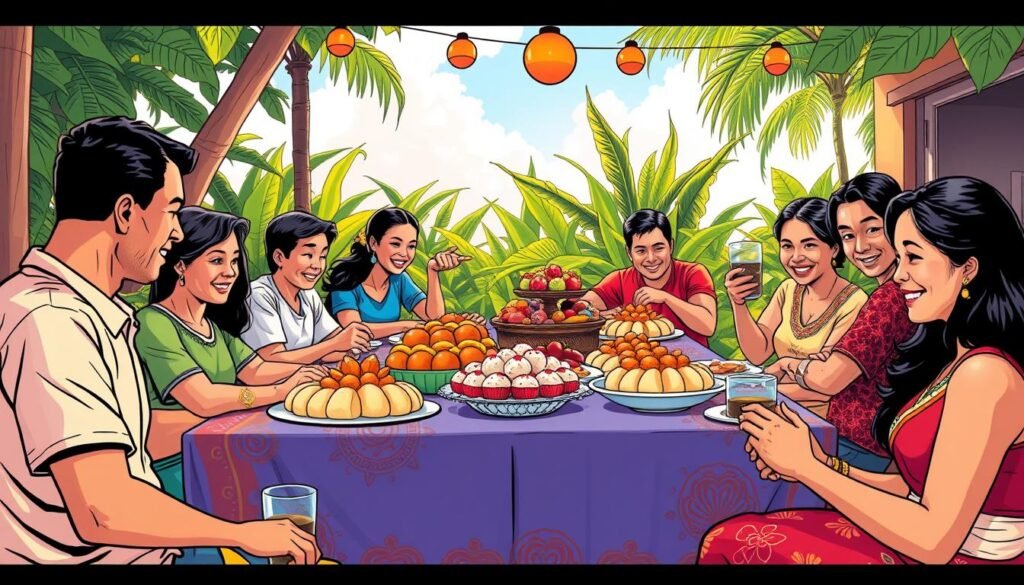
Future of Merienda in Contemporary Society
The and world in the is changing fast. Merienda in the Philippines is looking bright. Old favorites like pandesal, sari-sari, and kakanin are loved just as much today.
New gourmet merienda options are also popping up. They mix old recipes with new twists, bringing a fresh taste to midday.
Social media has changed how we enjoy merienda. Filipinos now share their merienda online, from bento-style snacks to stunning desserts. This sharing brings more joy and togetherness to this special tradition.
The younger generation is making merienda even more exciting. With their creativity, the future of merienda is full of possibilities.
FAQ
What is merienda?
Merienda is a Filipino tradition of midday snacking. It brings families and friends together. They enjoy delicious snacks and take a break from daily routines.
What is the history behind merienda?
Merienda started in the Spanish colonial period. The Spanish introduced their snacking traditions. These traditions evolved into the merienda we know today.
It has been shaped by Spanish, Chinese, and American cultures.
What are some common merienda foods?
Merienda foods include sweet treats like kakanin and puto. Savory options like chicharon and fish balls are also popular. They are often enjoyed with coffee, tea, or fresh juices.
What is the cultural significance of merienda?
Merienda is more than a snack. It’s a way to bond with family and friends. It’s a time to share stories and strengthen relationships.
It’s essential in Filipino celebrations. It shows respect and kindness to visitors.
When and how often is merienda typically enjoyed?
Merienda is enjoyed between 2-5 pm, when the sun is high. It’s a flexible tradition. It can be a quick snack or a leisurely break.
How does merienda vary across the Philippines?
Merienda traditions vary across the Philippines. Northern Luzon has sweet and savory snacks. Mindanao has unique offerings. This diversity shows the country’s complex history and cultural heritage.
How does merienda differ from other meal times?
Breakfast and lunch are formal meals. Merienda is casual and flexible. It provides a break between meals and a chance to refuel and recharge.
How have modern adaptations influenced merienda?
Merienda has evolved with modern adaptations. Fusion foods and healthier alternatives have been introduced. These innovations show the country’s culinary creativity and willingness to try new flavors and ingredients.
How can I experience the tradition of merienda?
You can experience merienda by preparing classic dishes. Explore street food culture. Or host a merienda gathering with family and friends.
These experiences give a glimpse into the rich history and cultural significance of merienda.
What is the future of merienda in contemporary society?
The future of merienda looks bright. Trends in pauper and gourmet merienda are exciting. Social media is also influencing merienda culture.
Mereda continues to evolve and adapt. It remains a beloved tradition in Filipino culture.
Source Links
- Filipino Snacks: A Delicious Introduction to Philippine Cuisine – https://foodventuresabroad.com/filipino-snacks/
- Why meryenda? – https://meryenda.substack.com/p/whymeryenda
- 9 Things You Should Know About Filipino Food – https://www.thrillist.com/eat/nation/filipino-food-guide-flavors-seasoning
- Merienda de Prayle – Wiki Malolos – https://wikimalolos.com/wikimalolos/index.php?title=Merienda_de_Prayle&mobileaction=toggle_view_desktop
- Filipino cuisine – https://en.wikipedia.org/wiki/Filipino_cuisine
- The History of Pinoy Snacks and their significance – https://pinoymerkado.com.au/history-of-pinoy-snacks/
- Guide to Merienda in the Philippines: Best Classic Filipino Snacks | Guide to the Philippines – https://guidetothephilippines.ph/articles/ultimate-guides/merienda-snacks-philippines-guide
- Merienda – https://en.wikipedia.org/wiki/Merienda
- How the Nostalgic Ritual of Merienda Satiated My Inner Child » FLUX – https://fluxhawaii.com/how-the-merienda-ritual-satiated-my-inner-child/
- Dissecting ‘merienda culture’ in the city – https://fnbreport.ph/21094/dissecting-merienda-culture-in-the-city/
- Spanish Meal Times & La Merienda – When and What to Eat | ParTASTE – http://partaste.com/la-merienda-spanish-meal-times/
- Redalyc.Frequency and quality of mid-afternoon snack among Spanish children – https://www.redalyc.org/pdf/3092/309252410011.pdf
- Age-related differences in eating location, food source location, and timing of snack intake among U.S. children 1–19 years – International Journal of Behavioral Nutrition and Physical Activity – https://ijbnpa.biomedcentral.com/articles/10.1186/s12966-023-01489-z
- Merienda in the Philippines — Live in the Philippines – https://liveinthephilippines.com/merienda-in-the-philippines/
- Food and drink in the Philippines | Where to eat in the Philippines – https://www.roughguides.com/philippines/eating-drinking/
- 11 Filipino Snack Time or Merienda Ideas | Lumina Homes – https://www.lumina.com.ph/news-and-blogs/blogs/filipino-food-for-merienda/
- A FILIPINO MERIENDA – https://rgarcellano.wordpress.com/2015/06/23/a-filipino-merienda/
- Merienda: A Light Meal for Afternoon (Spanish) – https://wordsoftheworlds.substack.com/p/merienda-a-light-meal-for-afternoon
- 🆚What is the difference between "tentempié " and "merienda " ? "tentempié " vs "merienda " ? – https://hinative.com/questions/17583281
- 20 Legendary Filipino Snacks and Merienda You Should Try in the Philippines – https://news.lindelatravel.com/2022/07/20-legendary-filipino-snacks-and-merienda-you-should-try-in-the-philippines/
- Nilupak na Saging (Filipino Mashed Banana) – Kusina Secrets – https://kusinasecrets.com/nilupak-na-saging-filipino-mashed-banana/
- Missing your office merienda? Try these 5 recipes you can recreate at home – Ajinomoto – https://www.cookmunitybyajinomoto.com/missing-your-office-merienda-try-these-5-recipes-you-can-recreate-at-home/
- 15 Filipino Snacks You Need to Try for Merienda | Will Fly for Food – https://www.willflyforfood.net/filipino-snacks/
- Filipino Food | Ajinomoto Philippines Corporation – https://www.ajinomoto.com.ph/category/filipino-food/
- 17 Popular Filipino Street Food Dishes to Try in the Philippines – https://www.willflyforfood.net/filipino-food-guide-discovering-philippine-street-food/
- Visit to IBM Philippines – https://oppositesideoftheworld.blog/2018/10/04/visit-to-ibm-philippines/
- 6 Easy-to-Make Merienda Housewives Can Sell for Extra Income | Cashalo – https://cashalo.com/6-easy-to-make-merienda-housewives-can-sell-for-extra-income/
- Filipino Food Month – https://www.platformbyjbf.org/event/brunch-merienda-an-afternoon-celebrating-filipino-food-month/
- Waterfront Mactan Celebrates Filipino Food Month – Waterfront Hotels & Casinos – https://www.waterfronthotels.com.ph/wahc-celebrates-filipino-food-month/
- It’s Merienda Time! – https://www.travelswithcharie.com/2012/02/its-merienda-time.html
- How To: Host a Merienda with the Girls – https://styleshops.com.ph/blogs/news/how-to-host-a-merienda-with-the-girls?srsltid=AfmBOorwrqFDlySBnOBT0TxybTT0fCj6T4IWCGQIuXt72e5QcUzGwbT2
- Old favorites for Sunday ‘merienda’ – https://lifestyle.inquirer.net/478059/old-favorites-for-sunday-merienda/
- Merienda-Top Five Important Things You Need To Know. – https://dotcommagazine.com/2023/10/merienda-top-five-important-things-you-need-to-know/
- Special Advertising Feature: The Modern Mom and Merienda – https://www.gmanetwork.com/news/lifestyle/food/372949/special-advertising-feature-the-modern-mom-and-merienda/story/

